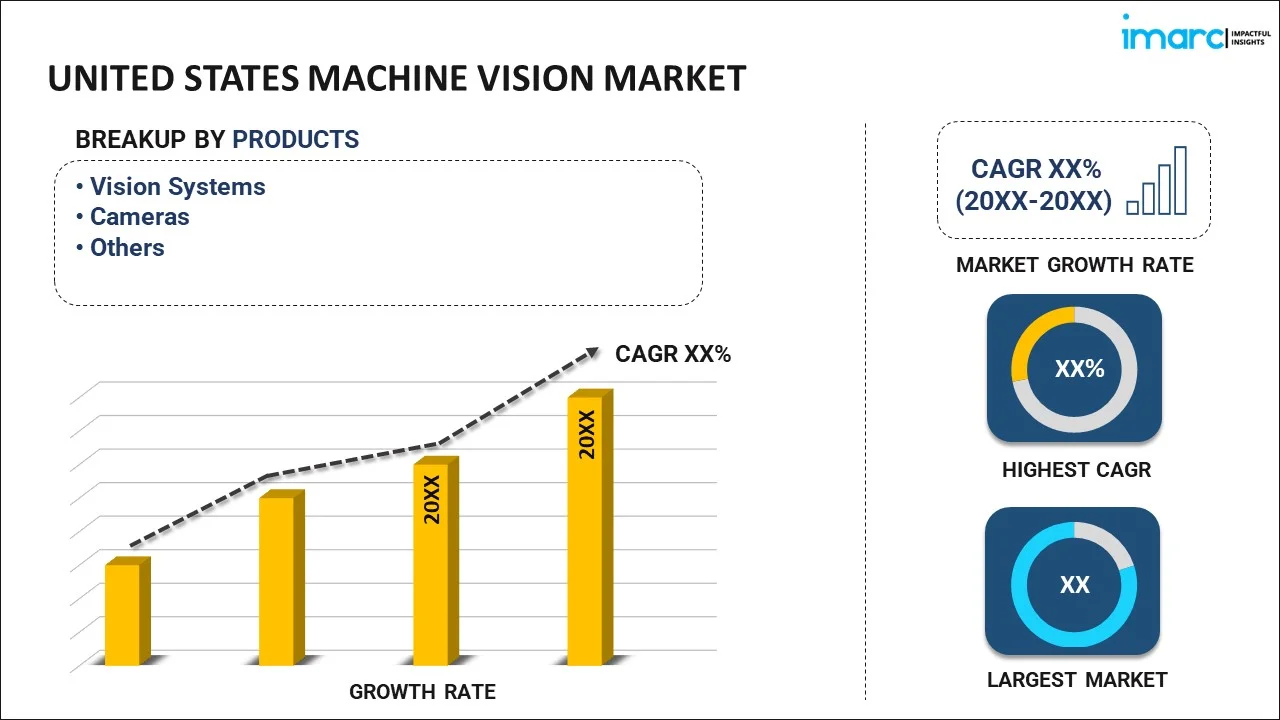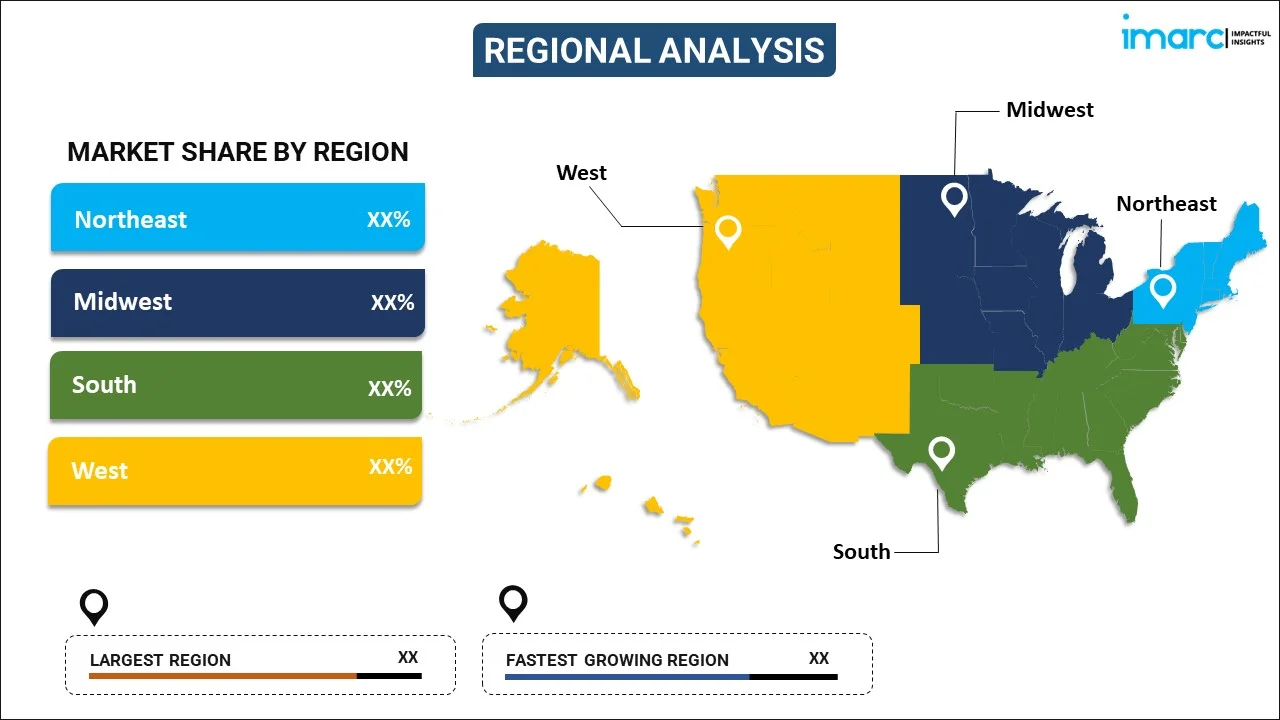
United States Machine Vision Market Report by Product (Vision Systems, Cameras, and Others), Component (Hardware, Software), Application (Positioning, Identification, Verification, Measurement, Flaw Detection, and Others), Industry (Electronics and Semiconductor, Automotive, Medical and Pharmaceutical, Food, Packaging and Printing, Security and Surveillance, Intelligent Traffic System, and Others), and Region 2025-2033
Market Overview:
United States machine vision market size reached USD 3.3 Billion in 2024. Looking forward, IMARC Group expects t he market to reach USD 19.9 Billion by 2033, exhibiting a growth rate (CAGR) of 22.3% during 2025-2033. The increasing automation in manufacturing, rising demand for quality control, advancements in machine learning (ML), growth in e-commerce and logistics, and applications in healthcare, defense, and agriculture represent some of the key factors driving the market.
|
Report Attribute
|
Key Statistics
|
|---|---|
|
Base Year
|
2024 |
|
Forecast Years
|
2025-2033
|
|
Historical Years
|
2019-2024
|
| Market Size in 2024 | USD 3.3 Billion |
| Market Forecast in 2033 | USD 19.9 Billion |
| Market Growth Rate (2025-2033) | 22.3% |
Machine vision refers to the technology that enables machines, typically computers, to interpret and make decisions based on visual data from the world. It involves the use of cameras, image sensors, and processing algorithms to mimic human vision and understanding. Machine vision systems capture and analyze visual information to perform tasks, such as object recognition, quality control, measurement, and inspection in various industries. These systems leverage advanced image processing techniques, pattern recognition, and artificial intelligence (AI) to interpret and extract relevant information from images or video streams. It is mainly used to allow machines to extract meaningful insights from visual data, performing tasks such as object detection, quality control, measurement, and identification. Moreover, machine vision is widely used across industries and plays a crucial role in automating processes, enhancing efficiency, and ensuring precision in manufacturing, logistics, healthcare, agriculture, and various other applications. As technology continues to evolve, machine vision systems are becoming increasingly sophisticated, leveraging advancements in hardware capabilities, deep learning, and real-time processing to meet the growing demand for intelligent and automated visual inspection solutions.
United States Machine Vision Market Trends:
The United States machine vision market is experiencing robust growth driven by the increasing adoption of automation and Industry 4.0 practices in the manufacturing industry. These technologies are integral to enhancing production efficiency, ensuring quality control, and minimizing defects in manufacturing processes. In confluence with this, the rise of e-commerce and the demand for streamlined logistics and supply chain operations contribute to the market's growth, with machine vision systems playing a vital role in package sorting, tracking, and quality inspection. Moreover, the surging product utilization across the semiconductor and electronics industry for intricate inspection tasks in chip manufacturing is acting as another significant growth-inducing factor. In confluence with this, the increasing employment of machine vision across the thriving automotive sector for tasks such as assembly verification, part inspection, and robotic guidance in automotive production lines is providing an impetus to the market growth. Concurrently, the increasing awareness and focus on safety and surveillance applications spurring the adoption of machine vision in the homeland security and defense sectors is creating a favorable outlook for market expansion. In addition to this, the expanding adoption of machine vision in video analytics, facial recognition, and license plate recognition enhancing security and monitoring capabilities are presenting lucrative opportunities for market expansion. Furthermore, the healthcare industry is witnessing the integration of machine vision in medical imaging, diagnostics, and robotic surgeries, which is fueling the market's growth. Apart from this, the growing use of machine vision in the flourishing agriculture sector for crop monitoring, yield estimation, and pest control, optimizing agricultural processes, and promoting sustainable farming practices is propelling the market forward.
United States Machine Vision Market Segmentation:
IMARC Group provides an analysis of the key trends in each segment of the market, along with forecasts at the country level for 2025-2033. Our report has categorized the market based on product, component, application, and industry.
Product Insights:

- Vision Systems
- Cameras
- Others
The report has provided a detailed breakup and analysis of the market based on the product. This includes vision systems, cameras, and others.
Component Insights:
- Hardware
- Software
A detailed breakup and analysis of the market based on the component have also been provided in the report. This includes hardware and software.
Application Insights:
- Positioning
- Identification
- Verification
- Measurement
- Flaw Detection
- Others
The report has provided a detailed breakup and analysis of the market based on the application. This includes positioning, identification, verification, measurement, flaw detection, and others.
Industry Insights:
- Electronics and Semiconductor
- Automotive
- Medical and Pharmaceutical
- Food, Packaging and Printing
- Security and Surveillance
- Intelligent Traffic System
- Others
A detailed breakup and analysis of the market based on the industry have also been provided in the report. This includes electronics and semiconductor, automotive, medical and pharmaceutical, food, packaging and printing, security and surveillance, intelligent traffic system, and others.
Regional Insights:

- Northeast
- Midwest
- South
- West
The report has also provided a comprehensive analysis of all the major regional markets, which include Northeast, Midwest, South, and West.
Competitive Landscape:
The market research report has also provided a comprehensive analysis of the competitive landscape. Competitive analysis such as market structure, key player positioning, top winning strategies, competitive dashboard, and company evaluation quadrant has been covered in the report. Also, detailed profiles of all major companies have been provided.
United States Machine Vision Market Report Coverage:
| Report Features | Details |
|---|---|
| Base Year of the Analysis | 2024 |
| Historical Period | 2019-2024 |
| Forecast Period | 2025-2033 |
| Units | Billion USD |
| Scope of the Report | Exploration of Historical and Forecast Trends, Industry Catalysts and Challenges, Segment-Wise Historical and Predictive Market Assessment:
|
| Products Covered | Vision Systems, Cameras, Others |
| Components Covered | Hardware, Software |
| Applications Covered | Positioning, Identification, Verification, Measurement, Flaw Detection, Others |
| Industries Covered | Electronics and Semiconductor, Automotive, Medical and Pharmaceutical, Food, Packaging and Printing, Security and Surveillance, Intelligent Traffic System, Others |
| Regions Covered | Northeast, Midwest, South, West |
| Customization Scope | 10% Free Customization |
| Post-Sale Analyst Support | 10-12 Weeks |
| Delivery Format | PDF and Excel through Email (We can also provide the editable version of the report in PPT/Word format on special request) |
Key Questions Answered in This Report:
- How has the United States machine vision market performed so far and how will it perform in the coming years?
- What has been the impact of COVID-19 on the United States machine vision market?
- What is the breakup of the United States machine vision market on the basis of product?
- What is the breakup of the United States machine vision market on the basis of component?
- What is the breakup of the United States machine vision market on the basis of application?
- What is the breakup of the United States machine vision market on the basis of industry?
- What are the various stages in the value chain of the United States machine vision market?
- What are the key driving factors and challenges in the United States machine vision?
- What is the structure of the United States machine vision market and who are the key players?
- What is the degree of competition in the United States machine vision market?
Key Benefits for Stakeholders:
- IMARC’s industry report offers a comprehensive quantitative analysis of various market segments, historical and current market trends, market forecasts, and dynamics of the United States machine vision market from 2019-2033.
- The research report provides the latest information on the market drivers, challenges, and opportunities in the United States machine vision market.
- Porter's five forces analysis assist stakeholders in assessing the impact of new entrants, competitive rivalry, supplier power, buyer power, and the threat of substitution. It helps stakeholders to analyze the level of competition within the United States machine vision industry and its attractiveness.
- Competitive landscape allows stakeholders to understand their competitive environment and provides an insight into the current positions of key players in the market.
Need more help?
- Speak to our experienced analysts for insights on the current market scenarios.
- Include additional segments and countries to customize the report as per your requirement.
- Gain an unparalleled competitive advantage in your domain by understanding how to utilize the report and positively impacting your operations and revenue.
- For further assistance, please connect with our analysts.
 Inquire Before Buying
Inquire Before Buying
 Speak to an Analyst
Speak to an Analyst
 Request Brochure
Request Brochure
 Request Customization
Request Customization




.webp)




.webp)












